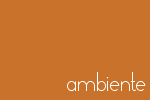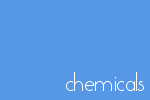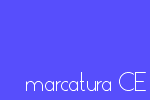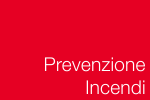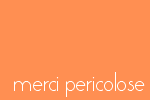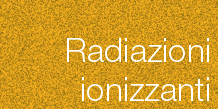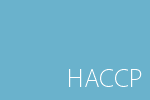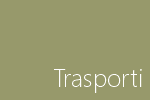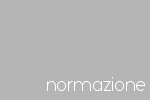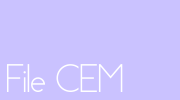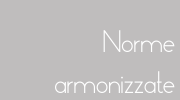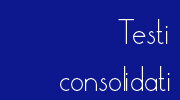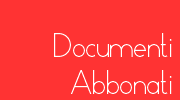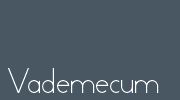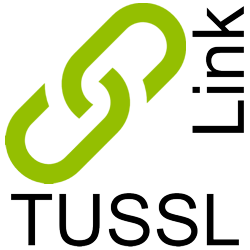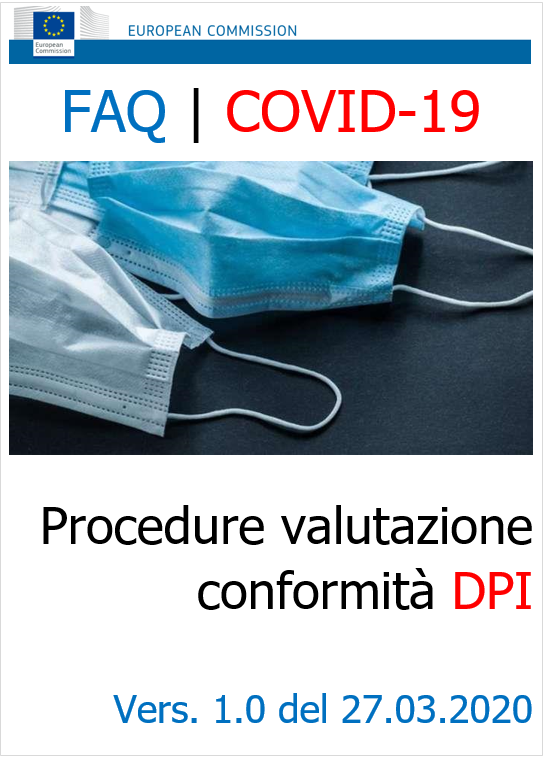EU FAQ | COVID-19: Procedure di valutazione conformità DPI
| ID 10475 | | Visite: 11422 | News Marcatura CE | Permalink: https://www.certifico.com/id/10475 |
EU FAQ | COVID-19: Procedure di valutazione conformità DPI
Conformity assessment procedures for protective equipment
Version 1: 27 March 2020
This document is addressed to prospective manufacturers of protective equipment. The document will be complemented on a regular basis in order to address any additional questions or concerns expressed by the economic operators.
N.B. These Guidelines are intended only to facilitate the application of Regulation (EU) 2016/425, Council Directive 93/42/EEC and Regulation (EU) 2017/745. However, the Commission accepts no responsibility or liability whatsoever with regard to the information in this document.
This information is:
- of a general nature only and is not intended to address the specific circumstances of any particular individual or entity;
- not necessarily comprehensive and complete;
- sometimes referring to actions of external actors over which the Commission services have no direct control and for which the Commission cannot assume responsibility;
- not professional or legal advice.
...
The COVID-19 is transmitted via small airborne droplets emitted by infected people when sneezing, coughing or talking. Therefore, a wide array of protective products designed to ensure protection against airborne particles or small droplets are used such as: face masks, gloves, coveralls, etc.
Most of these products are among the so-called ‘harmonised products’ for which there is specific EU product legislation in place. A majority of the products used in the context of the current health crisis, including FFP-type masks, are considered as Personal Protective Equipment (PPE) and hence fall under the scope of Regulation (EU) 2016/425.
Other products such as medical gloves, surgical masks, intensive care and other medical equipment are products falling within the scope of the EU legal framework on medical devices – Council Directive 93/42/EEC, to be replaced by Regulation (EU) 2017/745 as from 26 May 2020.
Each of the two legal frameworks fully harmonises the performance requirements for the products that it covers in order to ensure protection of the health and safety of users. Thus, products manufactured in accordance with these rules can circulate freely throughout the internal market and Member States may not introduce additional and diverging requirements regarding the manufacturing and placement on the market of such products.
Q2: Are there mandatory EU standards, which should be followed in order to produce protective equipment?
Both the PPE Regulation and the Directive on Medical Devices lay down essential requirements on health, safety and performance of the products they cover. However, both EU legal frameworks are technologically neutral and do not prescribe any specific mandatory technical solutions for the design of the products. Therefore, a number of technical solutions may be used by manufacturers to meet these essential requirements.
Both the PPE Regulation and the Directive on Medical Devices offer the possibility for manufacturers to rely on specific technical solutions, which are detailed in harmonised standards or parts thereof.
The references of these harmonised standards have been published in the Official Journal of the European Union. Where a manufacturer chooses to adopt such a technical solution, the product is presumed to be in conformity with the applicable essential health, safety and performance requirements.
In the case of face masks, the harmonised standards are EN 149:2001+A1:2009 for the FFP-type masks and EN 14683:2019 for surgical masks.
Compliance with the exact specifications laid down in these standards is not mandatory since manufacturers may choose to adopt different technical solutions. However, the major advantage offered by these technical solutions is that compliance with their prescriptions allows a swifter placement on the market. The reason is that the product does not have to be re-tested once again by a third party/certification authority prior to the placement on the market, if the manufacturer brings evidence that his product has passed all the necessary tests prescribed in the standard.
Q3: If a manufacturer chooses to follow the EN 14683 standard on surgical masks, who should perform the tests specified therein?
The tests are prescribed in the standard and can be performed by the manufacturer himself or by a laboratory on his behalf.
These tests are not strictly speaking a mandatory step prior to the placement on the market.
However, in case of control by the market surveillance authorities, if the manufacturer claims that the product complies with the standard, a sample may be tested in accordance with the test prescribed therein.
Q4: If a manufacturer intends to follow the EN 149 or EN 14683 standards, where can these standards be obtained?
European standards are copyright-owned by the European standardisation organisations which have developed them. Normally, manufacturers must purchase the standards they need from the national members of the European standardisation organisations, i.e. the national standardisation bodies.
However, to ensure that European industry can quickly respond to the increased demand for protective equipment generated by the COVID-19 outbreak, the Commission has agreed with the European standardisation organisation CEN that 14 standards (including EN 149 and 14683) will be exceptionally made freely and fully available by the national standardisation bodies.
Manufacturers can download the standards EN 149 and EN 14683 for free from the online catalogues of the national standardisation bodies.
Q5: Are there any other standards that can be followed in order to produce protective equipment?
Any standard or specific technical solution may be used provided that it complies with the applicable essential requirements laid down by the EU legal frameworks. While the harmonised standards (e.g. EN 149 and EN 14683 on masks above) tend to be the technical solution most widely used by the industry in the EU, there are other specific technical solutions which ensure a comparable level of safety.
The World Health Organisation guidelines on the choice of protective equipment provide a reference in that respect.
However, in contrast to the use of harmonised standards (EN 149 and EN 14683), where a manufacturer chooses to follow one of the alternative standards referred to by the WHO, a sample of the product should be tested by a notified body (third party testing body) in the case of products falling within the scope of the PPE Regulation In the COVID-19 context, the Commission issued on 13 March 2020 a Recommendation to facilitate the rapid uptake of new products on the EU market. On the one hand, the Commission urged all notified bodies (third party testing bodies) to prioritise any new requests submitted by manufacturers for COVID-19 related products. The attention of the notified bodies was drawn to the fact that the WHO guidelines could present alternative adequate technical solutions.
On the other hand, the Recommendation provides for two scenarios in which products, may be already placed on the market even if the conformity assessment procedures have not yet been finalised or, in some exceptional cases, even initiated:
1) If national market surveillance authorities find that equipment in the EU market ensure an adequate level of health and safety in accordance with the essential requirements set out in EU law, they may authorise these products on the EU market, even though the conformity assessment procedures, including the affixing of CE marking, have not been fully finalised.
2) In exceptional circumstances, products can be placed on the market even if the certification procedures have not been initiated and no CE marking has been affixed upon them, if the following cumulative conditions are fulfilled:
a) the products are manufactured in accordance with one of the EN standards or in accordance with any of the other standards referred to in the WHO guidelines or a technical solution ensuring an adequate level of safety;
b) the products are part of a purchase organised by the relevant Member State authorities;
c) the products are only made available for the healthcare workers;
d) the products are only made available for the duration of the current health crisis; and
e) the products are not entering the regular distribution channels and made available to other users.
The assessment of the specific technical solution as per point a) above is to be performed by a market surveillance authority in the course of the purchase process organised by the relevant authority of the Member State.
A number of national market surveillance authorities have already started implementing the recommendation and have developed testing protocols:
- On 20 March 2020, the Bavarian Central Authority of the Federal States for Safety published its testing protocol for face masks;
- On 20 March 2020, the Spanish Ministry of Industry, Commerce and Tourism issued a resolution laying down specific implementation measures;
- On 23 March 2020, the Dutch Health and Youth Inspectorate also communicated a decision on the assessment of the compliance of products manufactured in accordance with non-EU standards with the applicable safety requirements.
Q6: Is there any authorisation/mandatory certification that needs to be performed before the products are placed on the market?
Surgical/medical masks, examination gloves and some types of gowns (when supplied in non-sterile condition) are ‘Class I Medical devices’. As such, they do not require the mandatory involvement of a notified body (third party testing body) prior to being placed on the market. The manufacturer must certify that the product complies with the applicable requirements. This regime is essentially one of self-certification. If such devices are supplied in a sterile condition they are however classified in a higher risk class and a conformity assessment by a Notified Body is required.
Conversely, face masks and other equipment used in the COVID-19 context that are covered by the PPE Regulation are considered as ‘PPE of Category III’. Therefore, a notified body (third party testing body) must be involved in all cases. A sample of the product needs to be presented to such a body for assessment prior to placing on the market. However, under the PPE Regulation, once the initial sample is tested, there is no obligation to subject every single item coming off the production line to the same tests. Instead, there are supervised product checks at random intervals or other similar production control procedures, which are put in place.
Q7: Should the CE marking be affixed in all circumstances?
The CE marking is the final step, marking the end of all procedures prior to the placement on the market. In the case of some Medical Devices, the manufacture may affix this marking, without necessarily involving a third party (c.f. paragraph 1 of Q6 above). In the case of PPE items, the CE marking should normally be affixed by the manufacturer once the first sample of the product has been assessed and approved by the notified body (third party testing body) (c.f. paragraph 2 of Q6
above). In the specific COVID-19 context however, there might be derogations to this requirement in specific circumstances (c.f. sections 1) and 2) in Q5 above).
Please note that according to both legal frameworks, the CE marking should be affixed on each individual item.
Q8: Are there any specifications as to the exact materials to be used to manufacture face masks?
Neither the applicable EU legal frameworks, nor the harmonised standards EN 149 and EN 14683 impose any mandatory specifications as to the materials to be used. The legal frameworks essentially introduce performance requirements, which are further detailed by the relevant standards.
Therefore, manufacturers retain full choice as to the type of materials they can use.
In practice, in the case of FFP-type face masks, the following materials tend to be the most popular choice:
- Filter layer: Polypropylene;
- Valve (if applicable): Rubber or Polypropylene;
- Straps: Polyester, Polyisoprene, Lycra
- Seal: Polyethylene foam, Polyurethane etc.
- Clips/staples (if applicable): aluminium, steel
In the case of surgical masks, the material of choice tends to be a nonwoven material (S-M-S type) using a combination of melt-blown and spun-bond fabrics. The fabrics are usually based on Polypropylene.
...
Fonte EU
Collegati:
UNI EN 149:2009 | Marcatura CE semimaschere filtranti FFP
Decisione di esecuzione (UE) 2020/437
Direttiva Dispositivi medici 93/42/CEE
Coronavirus: Corretto uso delle mascherine
MDR Regolamento dispositivi medici | Reg. (UE) 2017/745
Rischio biologico Coronavirus | Titolo X D.Lgs. 81/08
Tags: Marcatura CE Direttiva Dispositivi medici Regolamento DPI Coronavirus




